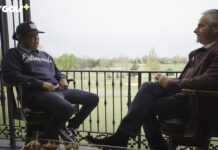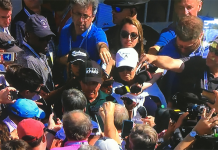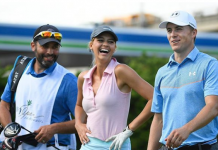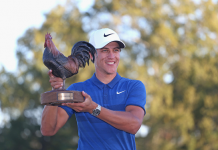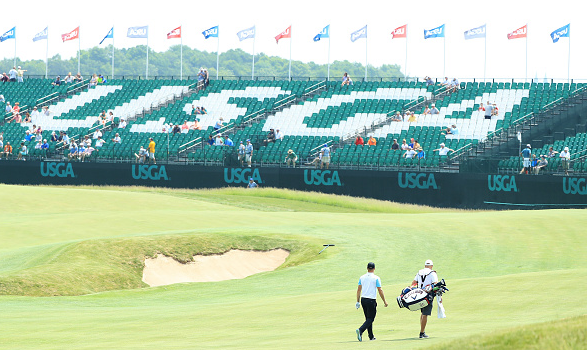
It is finally mid-June, which means that it is time again for the most anticipated and, hands down, toughest test in professional golf: the U.S. Open.
This year, that test does not come in the form of a questionably unfair par-70 setup with painfully compact fairways and a flagitious placement of trees and water hazards, like it often does.
The rough (be prepared to hear the word “fescue” often) is as unforgiving as always, if not more so, the greens will still be blistering, and the pros will still need to navigate a treacherous collection of bunkers, but Erin Hills, the site of this year’s U.S. Open, has two primary defenses in its quest to shut down the best of the best: length and wind.
It’s not just long, it is so long that the USGA made it the first par-72 U.S. Open since 1992. As for the wind, the course is designed in a way where the fast, swirling, despotic winds characteristic of America’s midwest can make an otherwise leisurely round of golf downright diabolical.
More than any other tournament in golf, the U.S. Open does not have winners as much as it has survivors.
History
It is now one of, if not the, grandest show in golf, but at its beginning, the U.S. Open was just an ancillary tournament to the highly regarded U.S. Amateur.
That inaugural event occurred in 1895, making the U.S. Open the second oldest of the four majors, and was held at the opulent Newport Golf Club in Newport, Rhode Island, the “in” summer hideaway of America’s wealthy and social elite at the time.
Played on Newport’s nine-hole course, the first U.S. Open was held in one day, with each of the 11 golfers in the field playing the course four times. Horace Rawlins, a 21-year-old from England, posted 91-82 to win the tournament by two strokes. He was awarded a $150 share of the $335 purse.
The following U.S. Open, held at Shinnecock Hills Golf Club, grew to a field of 35, a number that kept growing as the event started to increase in popularity.
Over time, the tournament developed a reputation for being the most challenging event in golf, allowing it to draw in the best of the best.
The U.S. Open boasts perhaps the most prestigious list of winners of any tournament. That list includes Walter Hagen, Gene Sarazen, Bobby Jones, Byron Nelson, Ben Hogan, Cary Middlecoff, Arnold Palmer, Jack Nicklaus, Gary Player, Lee Trevino, Tom Watson, Tiger Woods, and Jordan Spieth.
Hogan, Jones, Nicklaus, and Willie Anderson all share the tournament record for most wins, with four apiece. Tiger and Hale Irwin are next with three victories, followed by two apiece for Alex Smith, John McDermott, Hagen, Sarzen, Ralph Guldahl, Middlecoff, Julius Boros, Billy Casper, Trevino, Andy North, Curtis Strange, Ernie Els, Lee Janzen, Payne Stewart, and Retief Goosen.
A testament to just how difficult the U.S. Open has played historically, in 116 editions of the tournament just two players have finished double-digits under par: Tiger Woods (-12) at Pebble Beach in 2000 and Rory McIlroy (-16) at Congressional Country Club in 2011.
Even that 2000 event was brutal, as the two runner-ups, Ernie Els and Miguel Angel Jimenez, finished at +3, 15 strokes behind Tiger’s one-man show.
Past Winner Spotlight: Lloyd Mangrum (1946)
Not only an underappreciated golfer, but an underappreciated personality, Lloyd Mangrum was nicknamed “Mr. Icicle” both for being amazingly composed on the course, and his aloof demeanor.
It is surprising that someone so inherently calm could suffer 12 heart attacks in their life, like Mangrum did, but it becomes less surprising when it is considered that he chain-smoked during tournaments.
Mangrum won the 1946 U.S. Open, defeating Byron Nelson in a playoff, undoubtedly the best win of his impressive 36-victory career. While that 1946 triumph was his only U.S. Open win, he very well could have won several more.
The four U.S. Opens prior to his win were cancelled due to World War II, a war in which Mangrum received two Purple Hearts for his service. He was 28-31 of age in those four war years, an age that many pro golfers consider to be the prime of their career.
Mangrum also had a very close call in 1950, long before Dustin Johnson and Lexi Thompson were the subject of USGA controversy, when he was penalized two strokes for picking up his ball on the 17th green to swat away a bug, something which was permitted in PGA events at the time, but a violation of USGA (the organization who runs the U.S. Open) rules. Mangrum would then go on to lose to Ben Hogan in a playoff. He admitted later that he had never read the USGA rule book.
Course/Tournament Info
Name: Erin Hills
Where: Erin, WI
Distance: 7693 yards
Par: 72
Architects: Dr. Michael Hurdzan, Dana Fry, Ron Whitten
Purse: $12,000,000
Winning Share: $2,160,000
FedEx Cup Points: 600
Defending Champion
The defending champion of the U.S. Open is Dustin Johnson. At famed Oakmont Country Club near Pittsburgh, PA, Johnson started the day in a tie for second place, four strokes behind Shane Lowry.
Johnson shot a final round one-under 69 and overcame an intense USGA controversy to win the title by three strokes over Lowry, Jim Furyk, and Scott Piercy. Johnson was told by rules officials on the 12th hole that he may have committed a penalty earlier in the round, and that it would be reviewed after the match.
Despite the distraction, Johnson was immaculate down the stretch, breaking through for his first major championship.
Other Recent Champions
2015: Jordan Spieth
2014: Martin Kaymer
2013: Justin Rose
2012: Webb Simpson
2011: Rory McIlroy
Tournament Records
Lowest Final Score: The lowest final score at the U.S. Open was the 268 (-16) shot by Rory McIlroy in his eight-stroke 2011 victory at Congressional Country Club.
Low Round: 63 (Johnny Miller, Tom Weiskopf, Jack Nicklaus, Vijay Singh)
Television
Round 1: 11:00a-6:00p (FS1); 6:00-9:00p (FOX)
Round 2: 11:00a-6:00p (FS1); 6:00-9:00p (FOX)
Round 3: 11:00a-8:00p (FOX)
Round 4: 11:00a-8:30p (FOX)
Online
Website: USOpen.com
Facebook: Facebook.com/USOPEN
Twitter: @usopengolf
Instagram: @usopengolf
Storyline 1: Dustin Johnson Returns to the National Open
Dustin Johnson’s breakthrough major victory at last year’s U.S. Open at the brutally difficult (although they all are in this event) Oakmont Country Club was truly legacy-changing.
Over the course of those four rounds, Johnson was transmuted from the immeasurably talented player who always seemed to get in his own way on the big stage, to a celebrated major champion. It completely flipped his narrative.
The way he won also unanimously seen as admirable: he was able to fight off a USGA controversy that would have distracted most anyone. He didn’t even know what his score was going down the stretch. He just stayed composed and played so well that it ultimately did not matter if he was ahead by one stroke or three. Needless to say, DJ made myriad new fans on that June day.
The win no doubt earned him tremendous leeway with fans. He is no longer seen as a guy who needs to win a major. He could start to feel the pressure again if he goes on another extended winless major drought, but for now, he is simply considered to be great with no “buts”. At least for now, the pressure in that regard is off.
That all being said, there are still expectations. With his play since his U.S. Open triumph (six wins), DJ has gone from being considered one of the best golfers in the world to being recognized as the best in the world.
The world rankings at this time reflect a reality where there is Dustin Johnson and then there is everyone else. This will be his first major as the #1 in the world, since a freak back injury on Masters Eve cost him his latest chance at the green jacket.
The timing could not have been worse as Johnson was playing unquestionably the best golf of his life. He had won his previous three starts, with two of those coming in elite-field World Golf Championship (WGC) events.
Since coming back from that injury, he has been significantly less unstoppable with finishes of T2, T12, T13, and a missed cut in four starts. It is fair to say that one slip on the stairs drained DJ of a lot of momentum.
How he responds early on at Erin Hills is probably the #1 thing to watch for in the field of 156 golfers.
Storyline 2: European Flavor
Do not let the name of the tournament fool you; it isn’t just the Americans who are desperate to win the U.S. Open.
This tournament brings about one of the strongest fields of the year, and that field is an eclectic mix of players from all over the globe. It also provides the Tour’s European contingency another opportunity to attempt to exert superiority over the American game.
In this decade, the U.S. Open has had four European winners to three Americans. With another exceptionally strong crop, Europe could threaten that number further. Here are the top five players from the other side of the Atlantic to watch out for this week:
5. Alex Noren
If a casual sports fan was to take a glance at the Official World Golf Rankings, Sweden’s Alex Noren would likely stand out as the least recognizable name among the top 10.
Currently ranked #8, Noren plays the vast majority of his competitive golf in Europe where has five wins in the past 10 months, although he has been entering more PGA events as of late.
The 34-year-old has yet to seriously contend in a major, but with his tremendous recent form, that could change by the end of the week.
Noren has four finishes of T15 or better in his last six starts, highlighted by a win at the BMW PGA Championship, the flagship event of the European Tour. He was also T5 at the WGC-Dell Technologies Match Play, where an incredible comeback effort against tournament winner Dustin Johnson fell just short, and finished tenth at THE PLAYERS Championship.
His all-around game should make him competitive at Erin Hills, although his lack of length off the tee (he ranks outside the top 200 on the European Tour in driving distance) could be a real detriment to him.
4. Thomas Pieters
You said you want length? This guy has length. Possibly the brightest young star on the European Tour, Pieters is a big, strong player from Belgium who has already had some big moments on big stages.
He earned an incredible four points for Team Europe in last year’s Ryder Cup, and was a factor at both The Olympics and this year’s Masters, where he finished T4. He has been boom or bust in PGA events this season, but his best is definitely among the best in the world.
While Pieters does hit his driver long, he is also very erratic, so a key for him this week will be to stay out of the deep stuff, which is likely some of the thickest rough he will ever see.
3. Sergio Garcia
This will be Sergio’s first major as a past major winner, as the 37-year-old Spaniard finally added a major trophy to his mantle when he stared down an elite field at The Masters two months ago.
A precipitous drop in major pressure could bring out a healthier, carefree Sergio than we have seen at the U.S. Open in the past. Sergio leads the PGA Tour in scoring average and is second in total driving. His putting is always a question mark, but overall, Sergio has the game to make it 2-for-2 in 2017.
2. Rory McIlroy
If it was not for his recent lack of playing time, Rory, the #2 ranked player in the world, would be easily the #1 player on this list, and quite possibly the #1 for the entire tournament field.
He missed considerable time earlier this year with a rib injury, an injury he reaggravated at THE PLAYERS Championship last month, causing him to miss the BMW PGA Championship and The Memorial Tournament.
He is still trying to get 100% comfortable with his new TaylorMade clubs, which he switched to just a month ago, and he will be using a brand-new TaylorMade Spider Tour Red putter this week.
It is no doubt a quality putter: world #1 Dustin Johnson and world #3 Jason Day use the same kind, but it can take time to get intimately in synch with a new flatstick.
That being said, Rory is probably the greatest talent in the game. He has positive history at the U.S. Open, most notably when he absolutely annihilated the field at Congressional in 2011, winning by eight strokes and finishing -16, the lowest score to par in tournament history.
In addition, he has three other major victories and has always relished the big stage. If he can quickly get comfortable in his skin and with his new equipment, it would not be shocking to see him lap the field again.
With his up and down game, however, it would also not be shocking if he misses the cut entirely, like he did in 2012 and 2016.
1. Justin Rose
The 2013 U.S. Open winner at Merion, Rose should be exceptionally well-rested, as he has played just three events since his runner-up finish at The Masters, where he was defeated in a playoff by Sergio Garcia.
His uncharacteristically poor final-round 80 at THE PLAYERS Championship was concerning, but he was able to bounce back with a T12 the following week at the BMW PGA Championship.
Rose has 10 victories since 2010, not including his gold medal at last year’s Summer Olympic Games, with at least one win every full season in that stretch. He has yet to finish in the winner’s circle in 2017, but does have four finishes inside the top four.
Rose ranks above average or well above average in nearly every significant PGA statistic, and is one of the safest bets to play well at Erin Hills.
Storyline 3: Battle of the Young Guns: Spieth vs Rahm
While nothing in particular has signaled that Jordan Spieth and Jon Rahm are on the verge of becoming intense, bitter rivals, they are clearly the class of the PGA’s under 25 crowd, meaning a natural rivalry could definitely form.
The 23-year-old Spieth already has nine career victories, including two majors (the 2015 Masters and 2015 U.S. Open) while the 22-year-old Rahm has immediately asserted himself as being among the best on Tour.
Rahm turned pro after finishing T23 at last year’s U.S. Open as an amateur, and in the year since, he has nine top 10s with a win at the Farmers Insurance Open at the incredibly difficult Torrey Pines Golf Course. Both are ranked in the top 10 in the world, with Spieth currently occupying the 6th spot, and Rahm the 10th.
Both Spieth and Rahm have put together a phenomenal 2017 season. Spieth won the AT&T Pebble Beach Pro-Am, and has four additional finishes inside the top four.
Spieth ranks 2nd on Tour in scoring average, 2nd in birdie average, and 4th in Greens in Regulation (GIR). Combined with his already rich major championship experience, Spieth is among the favorites at every big event he enters.
Rahm does not have that same experience, but he has frequently looked beyond his years in his first full season. Along with the aforementioned win at Torrey Pines, Rahm has five additional top five finishes in 2017, including a runner-up finish at the WGC-Match Play and a T3 at the WGC-Mexico Championship. Rahm ranks 2nd on Tour in strokes gained: tee-to-green and 3rd in strokes gained: off-the-tee.
Nothing about the professional stage has looked too big for him.
Storyline 4: The Weather Delay Everyone Actually Wants
It is rare when golf fans root for a severe weather delay to begin a major tournament, but this year, that appears to be the case.
Fan favorite Phil Mickelson is just a U.S. Open short of the career Grand Slam, a U.S. Open tournament in which Phil has finished runner-up a record six times. He has said repeatedly that it is the tournament he most wants to win. However, he is unlikely to be at Erin Hills.
Mickelson announced less than two weeks ago that he will be in attendance at the high school graduation of his oldest daughter, Amanda, a graduation that occurs at 10am in Carlsbad, California (noon Central) this Thursday, the same day the U.S. Open tees off.
Phil was given a little help from the USGA when he was slated for a later tee time (2:20p local time), but he will still need significant help from Mother Nature to make it to Wisconsin on time.
After finishing solo-ninth at last weekend’s FedEx St. Jude Championship, Mickelson suggested that he would need at least a four-hour weather delay to make his playing a reasonable possibility.
Forecasts have called for a 20-60% chance of rain on Thursday (although more is expected in the morning than the afternoon), meaning there is a chance, however remote. Mickelson has stated that he will be happy either way, and he seems to have no second thoughts about the decision.
Storyline 5: Amateur Hour
One of the most lauded aspects of the U.S. Open is its inclusiveness to amateur players. Every year brings another look at America’s golf future, and this year is no different as 14 amateurs are set to tee off at Erin Hills.
While no amateur has actually won the U.S. Open since Johnny Goodman in 1933, there are some intriguing names in the field, and if an amateur is to break through, these are the most likely to do it:
3. Stewart Hagestad
A 26-year-old USC product, Hagestad was the low amateur at The Masters, where he finished T36. He qualified for The Masters by winning the 2016 U.S. Mid-Amateur, and qualified for the U.S. Opening through sectional qualifying. Hagestad does not intend to pursue a career in professional golf, instead opting for the business world, but he does tend to give it a go at Erin Hills.
2. Maverick McNealy
A 21-year-old who played his college golf at Stanford, McNealy was the 2015 winner of the Haskin’s Award, basically college golf’s Heisman equivalent. He also won this year’s Ben Hogan Award winner, which recognizes the best player in collegiate golf, voted on by the coaches.
1. Joaquin Niemann
A native Chilean, Niemann is currently the world’s #1 ranked amateur player. Just 18-years-old, Niemann has been dominant on the international amateur circuit, and recently won the Junior Invitational at Sage Valley.
Other Notables in the Field
Jason Day
World #3 Day has top 10 finishes in five of his last six U.S. Open starts, including runner-ups to Rory McIlroy (by eight strokes) in 2011 and Justin Rose (by two) in 2013. Due to injury and personal issues, Day, who started 2017 ranked #1 in the world, got his season off to a terrible start, but has shown signs of coming back around in his last two starts: a solo-second at the AT&T Byron Nelson and a T15 at The Memorial, a tournament he typically struggles in.
Day holds the all-time major record for lowest score to par (-20), which he reached in his 2015 PGA Championship victory.
Henrik Stenson
After a dominant 2016 where he won the Open Championship in record fashion and took silver at The Olympics, Stenson’s 2017 season has been very underwhelming.
At one point in March and April, he even missed four cuts in a row, but like Jason Day has started to show signs of life lately, with a T16 at THE PLAYERS Championship in a T3 at the BMW PGA Championship.
Rickie Fowler
Maybe the most popular player in the field, Fowler is likely to have one of the biggest followings at Erin Hills. Going into last year’s U.S. Open, Dustin Johnson was considered the best player without a major, but now that he is no longer majorless, that dubious label probably goes to Rickie.
Fowler He was runner up to Martin Kaymer at the 2014 U.S. Open, a season where he finished in the top 5 in all four majors, but missed the cuts by a mile in his last two attempts, finishing +14 after two days at Chambers Bay in 2015, and +11 for his two days of work last year at Oakmont.
His 2017 season has been phenomenal as he has five top 10s in just 12 events including a win at The Honda Classic and a runner-up at The Memorial. Fowler has been the complete package this year, as he leads the Tour in total driving, is 3rd in scoring average, 3rd in birdie average, and 7th in strokes gained: putting.
Justin Thomas
The 24-year-old Thomas was THE story of the season’s first few months, winning three tournaments in a four-month span, all before January ended. He even joined the 59 Club in the last of those victories, becoming the 7th ever to do it on the PGA Tour.
Thomas has cooled off significant since January, with several missed cuts and poor performances (a T75 at THE PLAYERS stands out), but he also had top fives in two elite field events: a T4 at the recent Memorial Tournament and a T5 at the WGC-Mexico Championship.
Kevin Kisner
Kisner could be considered a sleeper this week (if you have a very liberal definition of “sleeper”) since the field is so strong, but he is close to reaching a point where he is a perennial favorite.
The 33-year-old has followed up a fantastic 2016 with an even better 2017, winning the recent Dean & DeLuca Invitational, and finishing runner up at both the Zurich Classic and the Arnold Palmer Invitational. His most recent start was also encouraging: a T6 at The Memorial.
Kisner has yet to contend at a major, but in his current form, that could change soon.
Brooks Koepka
His length (5th on Tour in driving distance) and great putting, Koepka would seem to be a good fit for the lengthy Erin Hills course. He had seven top 10s in 2016, and was a productive member of the U.S. Ryder Cup team, but his 2017 has been inconsistent so far.
After a six tournament span where he missed four cuts and finished no better than T42, Koepka got hot in late March, and over his next four events he finished T9, T11, 2, T5. Since a T16 at THE PLAYERS, his game has started to trend the wrong way again, as he has finished outside the top 30 in his last three starts.
Si Woo Kim
The tremendous 21-year-old from South Korea has been a bit of a one-hit wonder in 2017, but that hit was a victory at THE PLAYERS Championship. Outside of TPC Sawgrass, however, Kim has been a non-factor, missing the weekend in 11 of 16 events, with nothing better than a T22.
Since that PLAYERS triump, Kim has a missed cut and a withdraw. Statistically, his season has been a disaster: he ranks 187th on Tour in strokes gained: off-the-tee, 175th in driving accuracy, 197th in driving accuracy, and 198th in scoring average, all signs that would seem to lean towards large difficulties at Erin Hills. Still, his victory was just one month ago, and at an elite event.
Lee Westwood
At 44 years old, many suspect that Westwood’s major window has closed, but he seems determined to prove them wrong. He has as much experience contending in majors as anyone in the field, with 18 tops 10s in majors without a victory. His best finishes at the U.S. Open are a solo third in 2008 and a T3 in 2011.
Just last year, he played in the final round on Sunday with Dustin Johnson, but while Johnson surged ahead of the field and captured his first major victory, Westwood was floundering badly, shooting a 10-over 80 and plummeting to T32. If he is ever going to win one of these, it probably needs to come very soon.
Shane Lowry
The 30-year-old Irishman Lowry held a four-shot lead going into the final round of last year’s U.S. Open, but couldn’t find his form on Sunday, posting a final round six-over 76, good for a second-place tie. He has not really contended on the PGA Tour since, but does look much better in 2017 than he did over the second half of 2016.
His last start, a T15 at The Memorial, was encouraging, and perhaps a sign that Lowry is ready to compete on the big stage again. He was also T6 at the European Tour’s recent BMW PGA Championship.
Martin Kaymer
Kaymer was dominant in his 2014 U.S. Open victory, winning at Pinehurst by an unbelievable eight strokes. That was his last win on either the PGA or the European Tour, and between the two, he has played much better in Europe.
On the plus side, he has not missed a cut in the U.S. in over a year, and rebounded very nicely after a first round 78 at The Masters, crawling his way up to 16th on the final leaderboard. He is still very accurate off the tees, currently ranking 14th on Tour in driving accuracy, and he is an historically great clutch putter. He is unlikely to be intimidated by having to play his first two rounds at Erin Hills with Dustin Johnson and Jordan Spieth.
Credit: Getty Images








